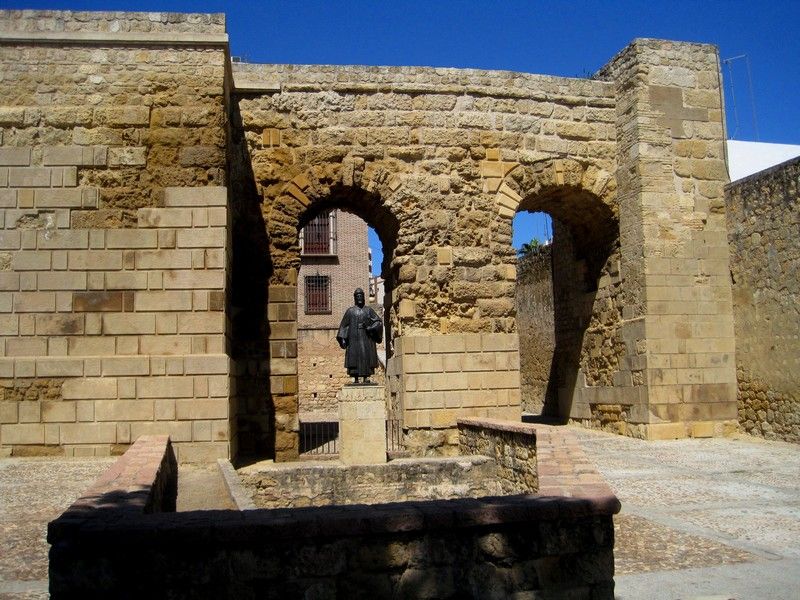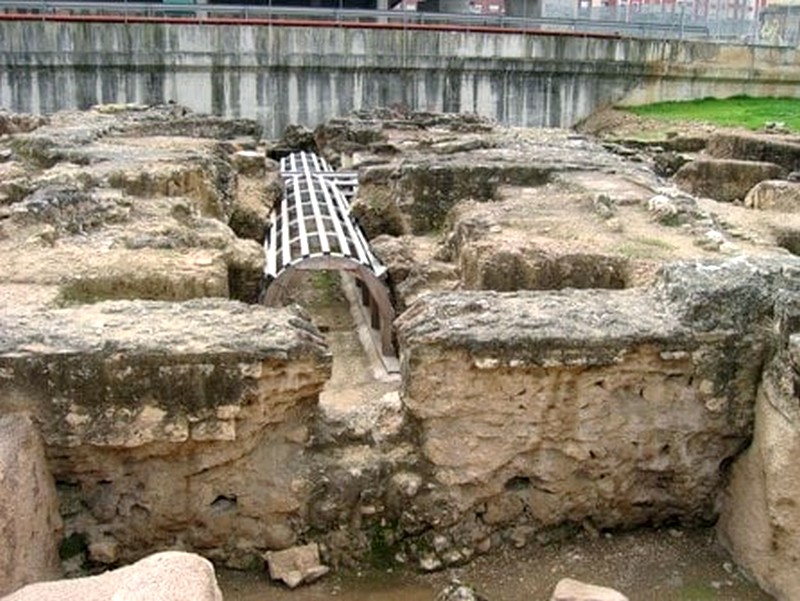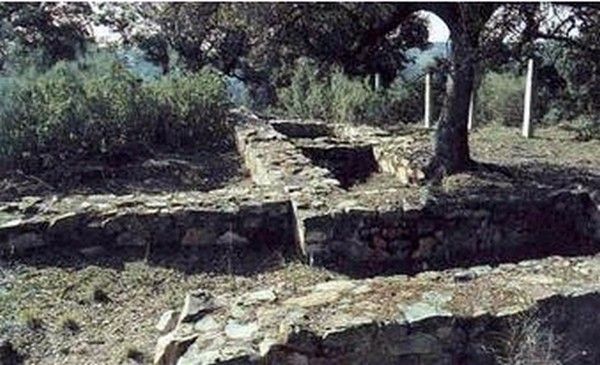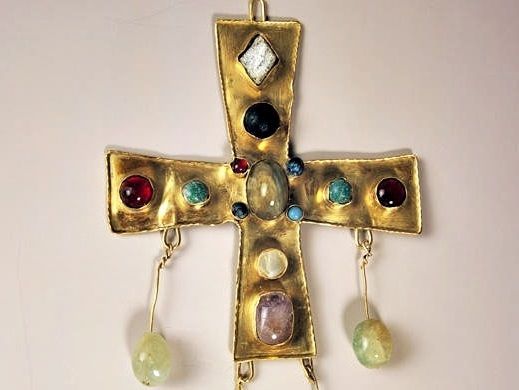Corduba (Córdoba)
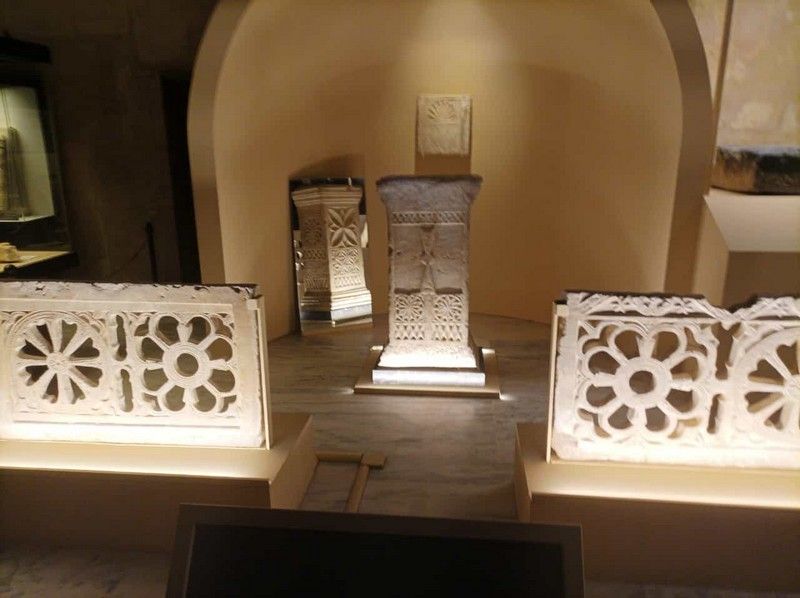
Historic environment
The classic city, Colonia Patricia, slowly transformed into another type of city, especially in two crucial centuries, the 6th-7th centuries.
Urban planning, the alternation of lots occupied by buildings is observed along with others in which the urban fabric was lost,  leaving some of them vacant. The area with the highest density was that close to the river and the bridge. Some suburban agglomerations grew around sacred buildings. The walled area was maintained, although the city grew beyond its walls. Some of its doors were blocked up and various canvases had to be restored in the face of the various attacks against the city in the years 550, 568, 572 and 584. We must remember that Corduba assumed a central role, due to its strategic position, in the struggles. carried out by Byzantines, Visigoth kings, Visigoth rebels and local aristocracy.
leaving some of them vacant. The area with the highest density was that close to the river and the bridge. Some suburban agglomerations grew around sacred buildings. The walled area was maintained, although the city grew beyond its walls. Some of its doors were blocked up and various canvases had to be restored in the face of the various attacks against the city in the years 550, 568, 572 and 584. We must remember that Corduba assumed a central role, due to its strategic position, in the struggles. carried out by Byzantines, Visigoth kings, Visigoth rebels and local aristocracy.
The orthogonal street with classical roots was largely dismantled, certain roads were privatized and new ones were created that did not maintain the old regularity. With regard to the hydraulic infrastructure, it is worth remembering that most of the city’s sewers in the 6th and 7th centuries faced the Guadalquivir, which implies that the conservation of that network by the authorities was manifestly insufficient. For the rest, numerous underground wells and rainwater cisterns were opened because the water that came from the river was not reliable given the dirt it carried. There was, however, an aqueduct in the western vicus that supplied water to the church of San Acisclo.
Description
With regard to the different churches, textual and archaeological information allows us to better draw the scenario of that Christian architecture. The current Mosque-Cathedral was occupied by a large episcopal palace that in two centuries (VI-VII centuries) could represent  the not inconsiderable extension of two hectares, possibly the largest classroom complex in late ancient Hispania. A recent excavation carried out in the Patio de las Naranjos of the Mezquita has confirmed this hypothesis, without evidence having been given to confirm the presence in this area of the famous church of San Vicente as a precursor of the Aljama.
the not inconsiderable extension of two hectares, possibly the largest classroom complex in late ancient Hispania. A recent excavation carried out in the Patio de las Naranjos of the Mezquita has confirmed this hypothesis, without evidence having been given to confirm the presence in this area of the famous church of San Vicente as a precursor of the Aljama.
In the suburban spaces, chronicle references give an account of three basilicas dedicated to San Acisclo, San Zoilo and the Three Crowns. However, we lack a precise location for these three churches, unlike what happens with Cercadilla, an imposing palatine, productive and cultural complex built by Maximino Herculeo. In fact, there was an important ecclesiastical area there.
There are few houses that have been excavated from this period in Córdoba. It is known that some domestic properties were abandoned, that different domus survived, transformed into tenement houses, and that areas previously designated for public performances, such as the theater, were occupied, but evidently lost that functionality.
Outside the wall, some agricultural centers linked to local elites, related agricultural activities survived throughout  the 6th and 7th centuries. Some of them will become, starting in the 12th century, Andalusian almunias. In addition to these agricultural centers, different craft activities dedicated to stonemasonry, ceramics and metalwork operated.
the 6th and 7th centuries. Some of them will become, starting in the 12th century, Andalusian almunias. In addition to these agricultural centers, different craft activities dedicated to stonemasonry, ceramics and metalwork operated.
To a large extent, the old suburban cemeteries of the most brilliant era of imperial Corduba disappeared to concentrate those uses around the basilicas (case of Cercadilla). In fact, the funerary geography underwent an intense process of Christianization, as can be seen from the good number of Christian inscriptions found in the city. Now, the number of tombs from the 4th-7th centuries is much lower than those found with imperial chronology, which may be due to a demographic contraction that seems common to so many Mediterranean cities at that time. In any case, the use of certain intramural spaces as cemetery areas has been detected, which must be interpreted as the assumption of this type of use by local aristocratic groups in palatine and domestic areas.
Rubén-Lot García Lerga for URBS REGIA
Other interesting information
Visiting hours, prices and conditions: Depends on the monument
Bibliography
– J. R. CARRILLO DÍAZ-PINES et alii, 1999. “Córdoba de los orígenes a la Antigüedad Tardía”, en F.R. García y F. Acosta (coords.), Córdoba en la historia: la construcción de la urbe, Córdoba, pp. 37-74.
– R. HIDALGO PRIETO, 2005. “Algunas cuestiones sobre la Corduba de la antigüedad tardía”, en J.Mª. Gurt y A.V. Ribera (coords.), VI Reunió d´Arqueologia Cristiana Hispànica, Barcelona, pp.401-414.
– S. JURADO PÉREZ, 2008. “El centro de poder de Córdoba durante la Antigüedad Tardía: origen y evolución”, Anales de Arqueología Cordobesa, 19, pp. 203-230.
– P. F. MARFIL RUIZ, 2000. “Córdoba de Teodosio a Abd al-Rahman III”, en L. Caballero y P. Mateos (coords.), Visigodos y Omeyas. Un debate entre la Antigüedad Tardía y la Alta Edad Media. Anejos de Archivo Español de Arqueología, 23, Madrid, pp. 117-141.
– J. F. MURILLO REDONDO et alii, 1997. “Córdoba: 300-1236 d.C., un milenio de transformaciones urbanas”, en G. de Boe y F. Verhaeghe (eds.), Urbanism in Medieval Europe. Papers of the “Medieval Europe Brugge 1997”, Conference, vol. 1, Zellik, pp. 47-60.
– J. F. MURILLO REDONDO et alii, 2010. “El área suburbana occidental de Córdoba a través de las excavaciones en el anfiteatro. Una visión diacrónica”, en D. Vaquerizo y J. F. Murillo, (eds.), El anfiteatro romano de Córdoba y su entorno urbano. Análisis arqueológico (ss. I-XIII d.C.), Monografías de Arqueología Cordobesa, 19 vol. I, Córdoba, pp. 99-310.
– G. PIZARRO BERENGENA, 2014. El abastecimiento de agua a Córdoba. Arqueología e Historia, Córdoba.
– M. D. RUIZ BUENO, 2016. Topografía, imagen y evolución urbanística de la Córdoba clásica a la tardoantigua (ss. II-VII d.C.). Tesis Doctoral (inédita), Córdoba.
– I. Mª SÁNCHEZ RAMOS, 2002. “La incidencia del Cristianismo en el mundo funerario cordubense”, en D. Vaquerizo (ed.), Espacios y usos funerarios en el Occidente Romano, vol. II, Córdoba, pp. 325-342.
– I. Mª SÁNCHEZ RAMOS, 2010. Corduba durante la Antigüedad tardía. Las necrópolis urbanas, Bar International Series 2126, Oxford.
– D. VAQUERIZO GIL y J.F. MURILLO REDONDO, (eds.), (2010a). El anfiteatro romano de Córdoba y su entorno urbano. Análisis arqueológico (ss. I-XIII d.C.). Monografías de Arqueología Cordobesa, nº 19, vol. II, Córdoba.
– D. VAQUERIZO GIL y J. F. MURILLO REDONDO, 2010b. “Ciudad y suburbia en Corduba. Una visión diacrónica (siglos II a.C.-VII d.C.)”, en D. VAQUERIZO (ed.), Las áreas suburbanas en la ciudad histórica. Topografía, usos y función, Monografías de Arqueología Cordobesa, nº 18, Córdoba, pp. 455-522.
– D. VAQUERIZO GIL, J. A. GARRIGUET y A. LEÓN MUÑOZ (eds.), 2014. Ciudad y territorio: transformaciones materiales e ideológicas entre la época clásica y el Altomedievo, Monografías de Arqueología Cordobesa, nº 20, Córdoba.
– A. VENTURA et alii (eds.), (2002). El teatro romano de Córdoba. Catálogo de la exposición, Córdoba.
Portals











